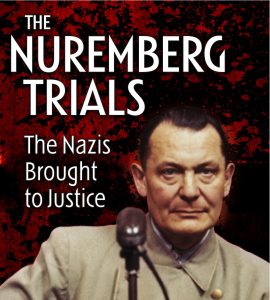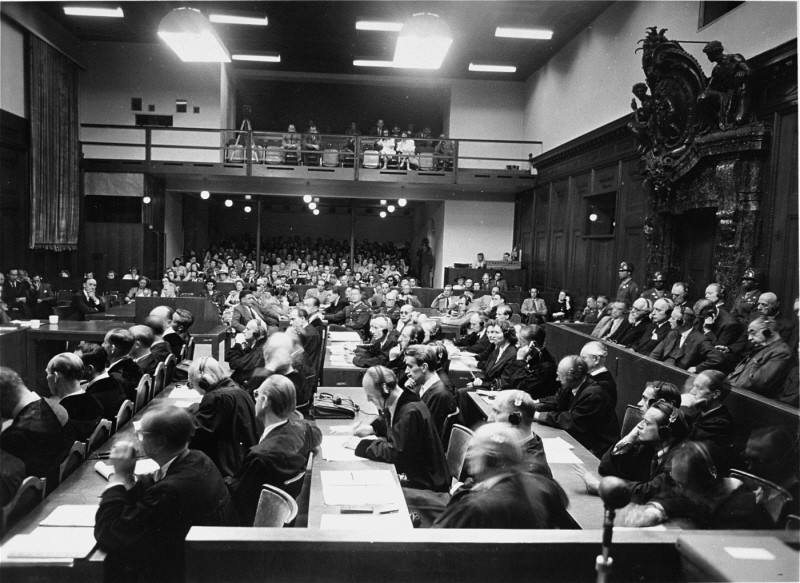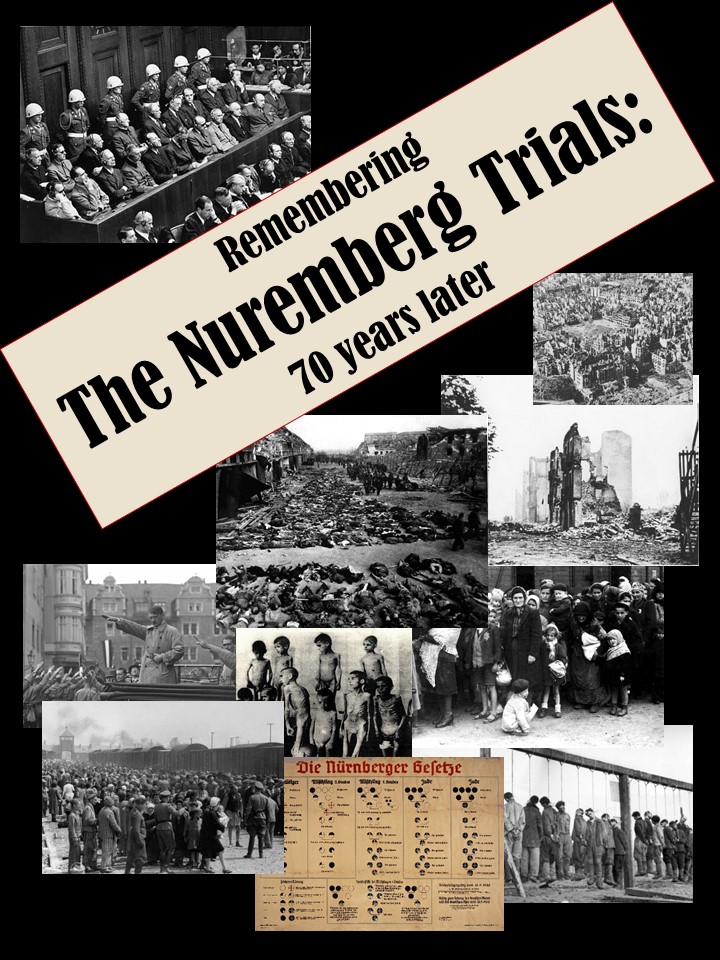
Page Description
Explore the Nuremberg Trials, where top Nazi leaders were brought to justice for war crimes, marking a pivotal moment in international law and human rights.
What were the Nürnberg trials?
The Nürnberg trials were a series of trials held in Nürnberg, Germany, in 1945 and 1946 following the end of World War II. Former Nazi leaders were indicted and tried as war criminals for their conduct by the International Military Tribunal.
Crime against humanity
A very serious crime, for example murder, committed against a civilian or group of civilians, usually ordered by a government or other people who have political power :
The former leader is charged with genocide, crimes against humanity, and war crimes.
The statute included rape as a crime against humanity when committed in armed conflict and directed against a civilian population.
Cambridge Dictionary
Proces Neurenberg uitgelegd in 17 minuten
De processen in Neurenberg zagen het einde van het regime dat de holocaust veroorzaakte en was de eerste keer in de geschiedenis dat een internationale rechtbank mensen veroordeelde tot de gevangenis … en tot de dood. Het zou later de weg banen voor het internationale hof van justitie, de universele verklaring van mensenrechten, en twee Verdragen van Genève.
PSYC12014 Episode 17 The Milgram Experiment and the Nazis part 1 of 2
25 aug 2023
00:00 – Start
01:34 – The Response from Mainstream Academics
NOTE: In the UK, I am called a ‘Critical Psychologist’. In Australia, which is where I presently live, the title ‘psychologist’ is a protected title used to denote psychologists who are registered with the Australian Health Practitioner Regulation Agency (AHPRA). I am not registered as a psychologist with AHPRA as I am not a qualified health practitioner – I am an academic and social activitist and I do not offer psychological services, I offer critical and political analysis to benefit those working to create progressive social change.
PSYC12014 Episode 18 The Milgram Experiment and the Nazis part 2
Educational
Educational
The Nuremberg Trials were a series of military tribunals held after World War II, in which top leaders of Nazi Germany were prosecuted for war crimes, crimes against peace, and crimes against humanity. Some key points about the Nuremberg Trials include:
The trials were held in Nuremberg, Germany from November 20, 1945 to October 1, 1946, and were conducted by a tribunal composed of judges from the United States, Great Britain, France, and the Soviet Union.
The trials were unprecedented in their scope and in the legal principles they established. The defendants were charged with crimes that had never before been defined under international law, including crimes against peace and crimes against humanity.
Twenty-four high-ranking Nazi officials were tried, including Hermann Göring, Rudolf Hess, and Albert Speer. Adolf Hitler, who had committed suicide in his bunker in Berlin, was not among the defendants.
The trials resulted in twelve death sentences, three life sentences, four prison terms ranging from 10 to 20 years, and three acquittals.
The Nuremberg Trials established the principle of individual responsibility for war crimes and crimes against humanity, which was later enshrined in the Universal Declaration of Human Rights and the Geneva Conventions.
The trials also established the concept of international law and the idea that individuals could be held accountable for crimes committed during times of war.
The trials were controversial, with some critics arguing that they were victor’s justice and that the defendants were not given a fair trial. However, the trials are generally seen as a landmark event in the history of international law and human rights.
1 From the 60 Minutes archive: Hitler’s secret archive
28 jan. 2021
2 Nazis on trial | DW Documentary
9 nov. 2020

3 The Twins of Auschwitz – Newsnight
28 jan. 2015
4 Nuremberg Executions 1946 – What Happened to the Bodies?
5 CARING CORRUPTED – The Killing Nurses of The Third Reich
24 feb. 2017
6 “They Gave Me Life” – The Story of Rina Quint
13 jan. 2020
7 Whose Child Are You?” The Story of Tswi Josef Herschel
27 apr. 2017
8 Surviving the Holocaust: Full Show
28 jan. 2016

9 The Silence After The End | Destruction (Nazi Doctors Documentary) | Timeline
26 mrt. 2020
10 The Madness Of The Nazi Experiments | Destruction (Nazi Doctors Documentary) | Timeline
19 mrt. 2020
11 The Crimes of The Auschwitz Doctors | Destruction ( Nazi Doctors Documentary) | Timeline
12 mrt. 2020
12 Surviving the Holocaust: Segment 6 — The Gas Chambers
3 feb. 2016
SHOCKING BEYOND WORDS
13 Alltag Holocaust: eine KZ-Aufseherin erinnert sich | Panorama | NDR
14 Holocaust Survivor Shares Auschwitz Horrors | Edith Eger | Goalcast
29 okt. 2020
15 The happiest man on earth: 99 year old Holocaust survivor shares his story | Eddie Jaku | TEDxSydney
18 jul. 2019
In this beautiful and moving talk, the self proclaimed “happiest man on earth”, Eddie Jaku shares his story of love and survival at TEDxSydney 2019. Eddie Jaku was a Jew living in Germany at the outbreak and throughout the duration of World War II. His story of survival spans 12 years, from Hitler’s rise to power in 1933 until liberation in 1945. He saw death every day throughout WWII, and because he survived, he made a vow to himself to smile every day.
Eddie Jaku OAM, born Abraham Jakubowicz in Germany in 1920.
His family considered themselves German, first, Jewish second. On 9 November 1938, the night immortalised as Kristallnacht, Eddie returned home from boarding school to an empty house. At dawn Nazi soldiers burst in, Eddie was beaten and taken to Buchenwald.
Eddie was released and with his father escaped to Belgium and then France, but was again captured and sent to a camp, and thereafter to Auschwitz. On route, Eddie managed to escape back to Belgium where he lived in hiding with his parents and sister.
In October 1943, Eddie’s family were arrested and again sent to Auschwitz where his parents were both murdered. In 1945, Eddie was sent on a ‘death march’ but once again escaped and hid in a forest eating slugs and snails until June 1945 he was finally rescued by.
Eddie has volunteered at the Sydney Jewish Museum since it’s inception in 1992. Self-proclaimed as ‘the happiest man on earth’, he saw death every day throughout WWII, and because he managed to survive, made a vow to himself to smile every day.
Edie has been married to Flore for 73 years, they have two sons, grandchildren and great grandchildren. This talk was given at a TEDx event using the TED conference format but independently organized by a local community. Learn more at https://www.ted.com/tedx
16 The deportation of Jews from Hungary and Lodz to Auschwitz Birkenau, 1944
9 apr. 2014
17 Holocaust Survivors – First Steps in the DP Camps and a New Beginning
25 mei 2015
“This video is part of the Holocaust Education Video Toolbox. For more videos and teaching aids, visit: https://www.yadvashem.org/education/e…
In the video, “Holocaust Survivors – First Steps in the DP Camps and a New Beginning”, ISHS staff member Sheryl Ochayon presents the story of the survivors, following the fundamental dilemma – “What Now?” – through to life and culture within the DP camps. She outlines the reality and remarkable phenomena within the DP camps, as well as their human significance in restoring a sense of personal identity and early steps towards a new beginning. The materials discussed in this video are available on our website and in teaching units produced at the ISHS.
Sheryl Silver-Ochayon is a staff member at the International School for Holocaust Studies, Yad Vashem.
part 1: The Return to Life in the DP Camps 00:00
part 2: A New Beginning 5:56
Archival footage and photographs:
Yad Vashem Photo Archive.
Yad Vashem Film Archive.
Yad Vashem Museum Collection.
Steven Spielberg Film and Video Archive, United States Holocaust Memorial Museum.
The Joint Archives, New York
Kibbutz Haogen’s Archive. Filmed by Yithak Herbert
Material and quotes from:
Study kit Return to Life – The Holocaust Survivors: From Liberation to Rehabilitation, produced by Beth Hatefutsoth, Tel Aviv; Ghetto Fighters’ House, Kibbutz Lohamai Hagetaot; Yad Vashem, Jerusalem;
Tel Aviv, 1995.
Yehudit Hemendinger, Perspectives on Holocaust Survivors. A Psychological Approach to the Study of the jewish People, Miriam Reiter-Tzedek, ed., The Institution for the Study of the Jewish People, May, 1984
Pinhas varshavsky. in Idit Witman, Unser Stimme (Our Voice), the first journal of the survivors, Gesher 4, 1987.
2. The Anguish of Liberation – Testimonies from 1945, edited by Y.
Kleiman and N. Springer- Aharoni, Yad Vashem, Jerusalem, 1995.
3. Yad Vashem Archives
Every effort has been made to locate the copyright holders to obtain the appropriate permissions and apply the correct attributions. If you have any information that would help us in relation to copyright, please contact us internet.education@yadvashem.org.il
IMPORTANT CONTENT
19 Nazi prejudice and propaganda – the racist crimes against the “children of shame” | DW Documentary
10 jan. 2021
After World War I, relationships between French occupation troops and German women were banned. But they happened anyway, and liaisons involving black soldiers produced a number of mixed-race children. Many were later persecuted by the Nazis.
Around 100,000 French troops were sent to occupy Germany’s Rhineland region in 1920. About 20,000 of these soldiers came from the French colonies of Tunisia, Morocco, French Indochina, and Senegal.
The African troops became targets of a harassment campaign called “Die Schwarze Schmach,” or “The Black Disgrace.” German political parties, the media, and many organizations tried to discredit French occupation policies by falsely claiming that black French soldiers were systematically raping German women and children. The presence of black, North African, and Asian troops in Germany was depicted as a threat to the “German race” and the future of European civilization.
Between 1919 and 1928, several hundred mixed-race children were born in Germany’s Rhineland region — the product of liaisons between local women and French occupation troops. These children, their mothers, and extended families were socially ostracized from the very beginning.
In the 1930s, these children became victims of racist Nazi policies. In 1937, Adolf Hitler secretly ordered hundreds of them to be forcibly sterilized. A special unit of the Gestapo was set up to carry out this task.
This documentary, directed by Dominik Wessely, tells the story of a forgotten crime. It also explains how propaganda and toxic “fake news” reports can create an environment in which horrific crimes can be committed.
——————————————————————-
DW Documentary gives you knowledge beyond the headlines. Watch top documentaries from German broadcasters and international production companies. Meet intriguing people, travel to distant lands, get a look behind the complexities of daily life and build a deeper understanding of current affairs and global events. Subscribe and explore the world around you with DW Documentary.
18 sep. 2017
21 Een reconstructie van het proces van Neurenberg | ANDERE TIJDEN
3 jun. 2020
22 Hermann Göring’s Mysterious Death
27 jul. 2020
23 — 3767 18 The Nuremberg Trials The Great Trials of World History and the Lessons They Teach Us
24 JFL Hidden Camera Pranks & Gags: Electrocuted Puppy
24 feb. 2011
In this prank, bystanders are made to believe their negligence caused the death by electrocution of a cute little puppy.